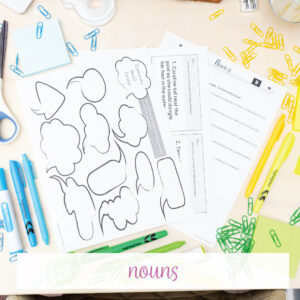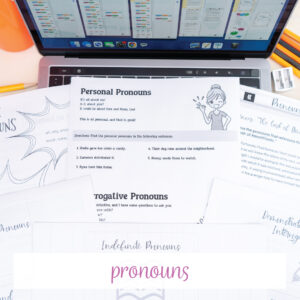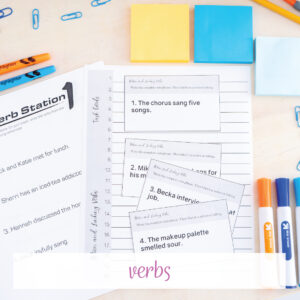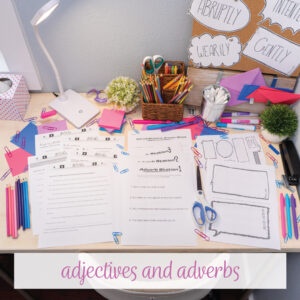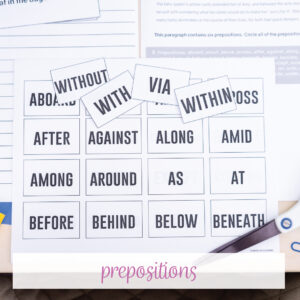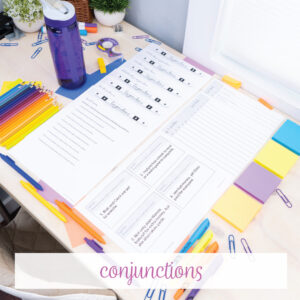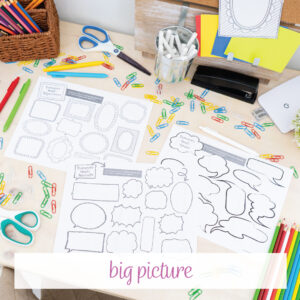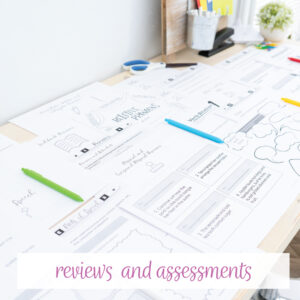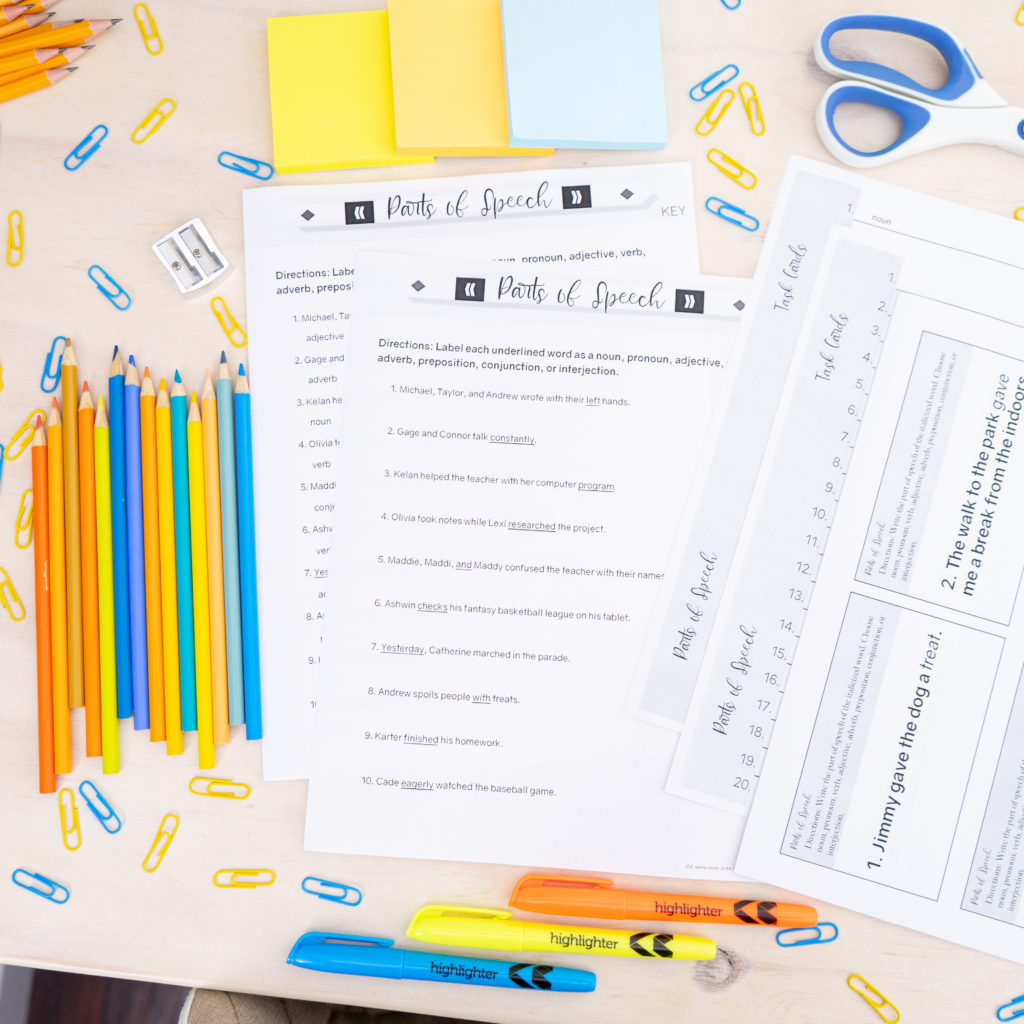Are you looking for creative ways to teach the eight parts of speech? Below, I’ve outlined my parts of speech lessons for older students. . . often my first set of grammar activities.
So, you’re going to teach the eight parts of speech. . . often during those first weeks of school. Hmmmmmm. I have a method, a method that I created after years of experience. I’ve detailed it below.
First, consider methods with how to teach parts of speech. You can use a worksheet every day for every lesson, but students rarely retain information if they only see the information presented one way. Instead, consider how you teach other concepts in your classes. You probably utilize an assortment of activities like station work, task cards, coloring sheets, and graphic organizers.
Second, I included tons of parts of speech activities—I would never use all of these with one class. Over the years, I have taught many ages with a variety levels of grammatical understanding.
Only use what works for you and your students in your lesson plan!
What are the eight parts of speech?
The eight parts of speech are noun, pronoun, verb, adjective, adverb, preposition, conjunction, and interjection. These are the basic building blocks of the English language and understanding them is essential for effective communication and writing.
A few notes about these notes for teaching the eight parts of speech:
- First! I don’t pretend that my older students have never heard these terms before. We review for the manipulation and analysis for which older students should strive.
- As a general guide to my parts of speech grammar lessons below, I’ve provided headers in bold. Read the specifics underneath because I work to overlap the material while differentiating for all the levels in my classes.
- Also? I don’t think there is one “right” way for grammar lessons. This format works for me. Take what works for your students. . . I tried to be accurate and thorough.
- You can purchase the grammar lessons for teaching the parts of speech I mention below. You don’t have to purchase those exact parts of speech lessons, though!
Now, we are ready! Here are my parts of speech lessons.
Week One: Pretest/ Nouns
Considering middle school grammar, I know that my students’ experiences and knowledge greatly varies. Therefore, I start with a pretest. Then I take information from the language pretest and divide it into areas for improvement. When possible, divide practice among students (task cards help with individual practice).
Finally, I provide that information to students and tell them that we’ll work to improve those areas. Grammar lessons can be interesting, and I establish early with students that language is diverse and requires multiple practice opportunities.
After the pretest, I begin with direct instruction with nouns. (Note: as I continue these parts of speech lessons, I’m writing about what normally happens. If students understand nouns, for example, we don’t complete lessons over them.)
Students may take notes however they wish—many choose note cards, but some choose flipping books or infographics. Since my older students feel that different parts of speech are “babyish,” I try to give them freedom in certain areas, like with note taking. Then I might organize how I teach the eight parts of speech like this:
- I have presentations that outline all of the material concerning each part of speech lesson. All of our assignments branch from that information, and students know to consult that information. We will work through identifying nouns that first week in an assortment of ways: worksheets, task cards, coloring sheets, centers, and grammar manipulations.
- When students arrive on a Monday, I give the direct instruction over the concept. Students practice, often together or with me.
- The following days of the week, we reinforce that skill. It might be direct grammar materials, but it might also be through vocabulary or mentor sentences. When students complete an assignment (for instance in week one, nouns), they move onto the area I’ve told them to study from their pretest.
- Finally, I focus on differentiation. For example students work on personal pronouns, conjunctions, verbs, or modifiers as extension work. Sometimes they have a specific exercise, like reviewing an online website or a Powerpoint.
- Another option for differentiation (that I base on that pretest) is for me to sit with different groups. Students who need to practice prepositions, for example, benefit from a quick review with me. Since they struggled in that area on the pretest, I don’t worry about their being bored during the direct instruction in subsequent weeks.
At this point in their schooling, these students have experienced numerous parts of speech lessons. They still need review for advanced discussions.
NOTE! I repeat this format for direct instruction and practice in the following weeks. If students begin to excel with their extra practice (from the pretest), I will switch how I teach the eight parts of speech for subsequent lessons.
Week Two: Pronouns, not relative pronouns
Pronouns: so many of them! Part of any English grammar less must include a discussion over pronouns and their changing role in language. When I teach the eight parts of speech, I include a discussion that language evolves.
My students make anchor charts of pronouns. To begin, we practice all pronouns except relative pronouns: indefinite, personal, compound personal, interrogative, and demonstrative. (Whew.) We discover examples of pronouns and consult our charts.
I acknowledge this is tons of material, and that is why we cover it so early. I remind students that for subject-verb agreement (especially with indefinite pronouns), they will need to know them.
When learning large chunks like pronouns, I’ve found it helpful to both continuously find those pronouns in other areas of class, and to also explain to students why they will use that information later.
Week Three: Verbs
Students must be able to locate a verb in different circumstances of writing. I once taught verbs after adjectives, but to reinforce both nouns and pronouns, I switched. (As you continue building your methods to teach the eight parts of speech, you’ll discover what works best for you.)
With verbs, I tell students they must memorize linking verbs. I help them: you can read how I “act out” verbs. This really sticks, and students run through that process when deciding if a verb is a linking or action one. Plus, connect grammar to writing here. Powerful verbs can improve writing.
Plus, every sentence you read will have a verb! Finding examples of verbs is easy.
Week Four: Adjectives and Adverbs
For modifiers, we have two direct instruction days. We cover adjectives and practice with nouns and pronouns. Normally on Wednesday, we have direct instruction over adverbs. This creates a loop of practice of everything we have studies so far. As I continue to teach the eight parts of speech, I gather when students need a pause and when they need review.
I continue to consult with students about their pretest practice. I start switching students, assigning new Powerpoints and practice sheets based on what they feel they need. As we continue, students are often all reviewing different concepts at different times. Grammar has many moving pieces, and parts of speech lessons probably won’t be linear.
Week Five: Prepositions, with more adjectives and adverbs review
Most students find prepositions easy once they familiarize themselves with the list. They even find prepositions fun; they are amazed at how many we use in our writing and speaking. (My free grammar lessons contain a specific activity for prepositions.) Finally, teaching prepositions allows me to build on prior knowledge and connect grammar to writing. Overall, students do well with prepositions.
The biggest part of studying prepositions is to find the objects, which then loops back to nouns and pronouns. Older students must identify prepositional phrases for proper punctuation. Whenever I think ahead (connections to writing or punctuation) during parts of speech lessons, I’m sure to explain that to students.
Week Six: Conjunctions, not subordinating conjunctions
Much like pronouns, I don’t teach all conjunctions the first week; I cover all except for subordinating conjunctions. Most students understand FANBOYS and will recognize the pieces of correlative conjunctions. (I give them the visual that they are puzzle pieces, and they must find the missing piece of the puzzle.)
After student see the sentence format for conjunctive adverbs, they are comfortable with them. When students have trouble with conjunctions, I have them keep the lists on their desks as we practice.
Of course, conjunctions join the previously studied parts of speech, and I will add on quick practice. Ask students to identify what is joined or to label all the nouns (for example) in their sentences.
Week Seven: Subordinating conjunctions, subjects
This week, I already start review, but I add in subordinating conjunctions. Students write those and keep that list on their desks. In our final assessments, I do not quiz over those just yet. Students struggle with those, so I give them extra time for mastery. If I am teaching sixth grade, I might not review subordinating conjunctions. Seventh graders, however, need to understand subordinating conjunctions for sentence structure.
I will often walk students through finding the subordinating conjunctions, and then we will find the conjunction’s subject (a noun or a pronoun) and verb. We will discuss if the noun, pronoun, and verb have any modifiers.
If at any time, students become overwhelmed, we make parts of speech posters together.
Week Eight: “Big Picture”
I mention interjections, which normally takes five minutes. An interjection is an individual word that interjects, that exclaims.
If you want to have a bit of fun as you teach the eight parts of speech, ask students to punctuate and write some interjections. Students feel successful, and that’s a nice ending to the direct instruction for different words.
We start to put all of the parts of speech lessons together, more so than we have in previous weeks. I run through sentences with students and demonstrate how they can now label each word in a sentence.
I will also have students write sentences for me, and I will deconstruct them. That is actually a practice I continue all year; students try to “stump” me with difficult sentences to label. (You can use my free grammar lessons to start discussions.) Often, this week includes honest discussions about the purpose of eight parts of speech activities: We are building a foundation, we are gaining perspective, and we are connecting language to other parts of our lives.
 Week Nine: Reviews and Assessments
Week Nine: Reviews and Assessments
We have final assessments, some of which might float into the tenth week dependent upon holidays. My favorite is to bring in food and analyze the ways language is used in real life. (Plus the kids get to eat.) Analyzing food goes beyond an eight parts of speech lesson, but if students are ready for application and analysis, diving into marketing is an authentic assessment.
Next, we move onto parts of a sentence, but as I like to tell students, they already have the foundation for that. Middle or high school students are looking at the language in a new way with different purposes. They have the foundation: the eight parts of speech.
And, that is a very quick overview of how I teach the eight parts of speech! Don’t forget to download my free grammar lessons to use the entire school year.
Tips to teach the eight parts of speech:
- Build the grammar lessons. Week one, we study nouns, but we never stop studying them. We identify nouns in relation to adjectives, in the stories we read, and in the vocabulary we study. Continually use domain-specific language.
- A message I always send students is that grammar is like building blocks. We’re laying the foundation. I trust that they know nouns, and we continue to study them. You can watch this free video that details how I talk to students about the “big picture” of grammar.
- I don’t ignore subjects and verbs. Older students know those terms. When we identify verbs, I ask students to find the subject – which is probably reviewing nouns and pronouns.
- I do expect all students to have a grasp of the eight parts of speech, and I encourage students to teach each other. Older students can show each other tricks and develop anchor charts for the class. Since they are older, I give them as much ownership as possible.
- Again, I never stop talking about the parts of speech. I make it a point to mention if an author uses an abundance of prepositional phrases, or repeats a noun, or is vague with pronoun use. Students should realize that grammar filters into all parts of an ELA class!
This grammar bundle contains every activity I use to teach the eight parts of speech.
Do you still have questions about grammar for high school, general grammar lessons, and parts of speech lessons? Join us at Grammar Gurus. It’s a private Facebook page full of helpful teachers who are devoted to teaching grammar in meaningful ways.



